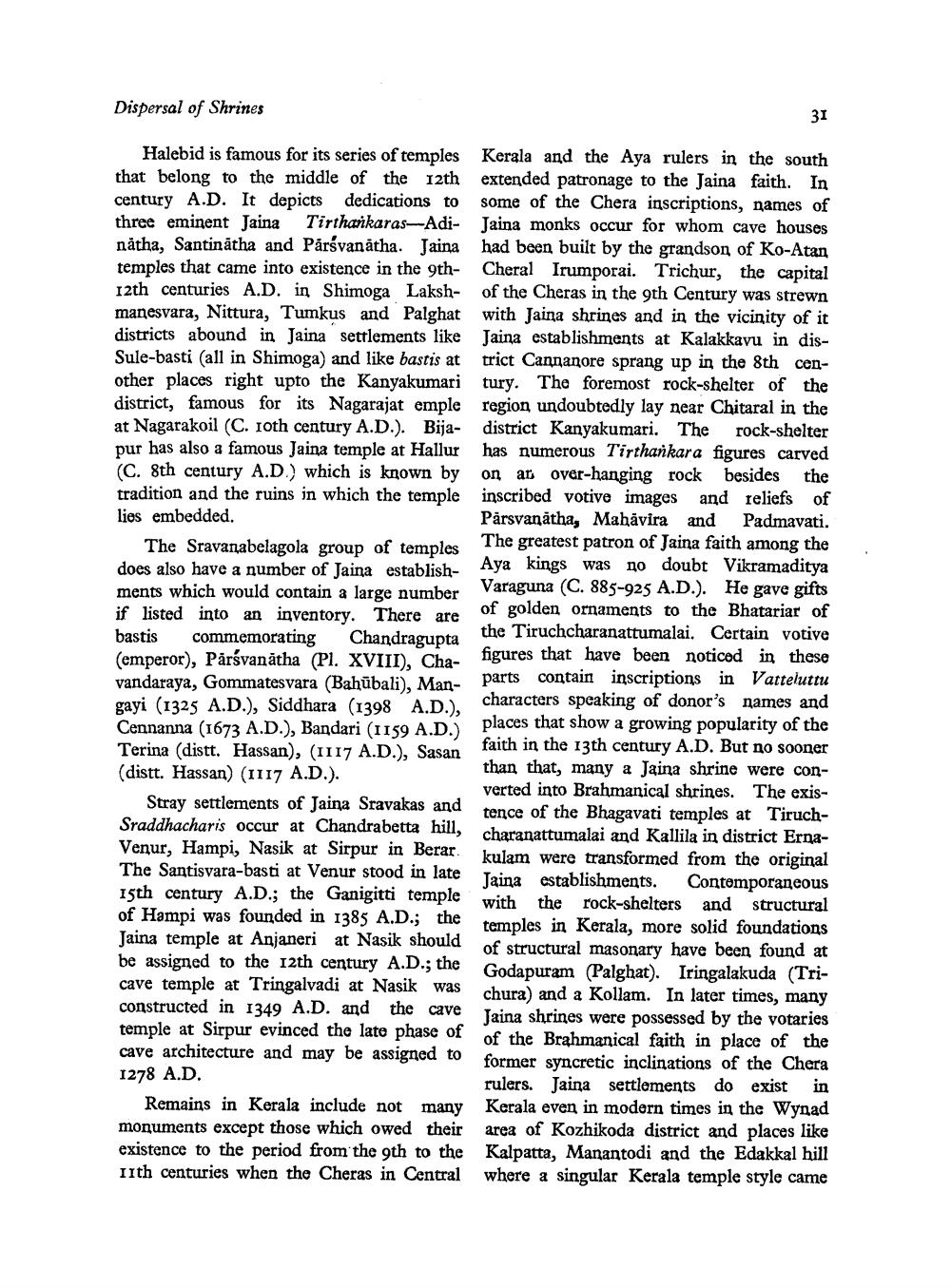________________
Dispersal of Shrines
Halebid is famous for its series of temples Kerala and the Aya rulers in the south that belong to the middle of the 12th extended patronage to the Jaina faith. In century A.D. It depicts dedications to some of the Chera inscriptions, names of three eminent Jaina Tirtharkaras-Adi- Jaina monks occur for whom cave houses nátha, Santinātha and Párávanātha. Jaina had been built by the grandson of Ko-Atan temples that came into existence in the 9th- Cheral Irumporai. Trichur, the capital 12th centuries A.D. in Shimoga Laksh- of the Cheras in the 9th Century was strewn manesvara, Nittura, Tumkus and Palghat with Jaina shrines and in the vicinity of it districts abound in Jaina settlements like Jaina establishments at Kalakkavu in disSule-basti (all in Shimoga) and like bastis attrict Cannanore sprang up in the 8th cenother places right upto the Kanyakumari tury. The foremost rock-shelter of the district, famous for its Nagarajat emple region undoubtedly lay near Chitaral in the at Nagarakoil (C. 1oth century A.D.). Bija- district Kanyakumari. The rock-shelter pur has also a famous Jaina temple at Hallur has numerous Tirthankara figures carved (C. 8th century A.D.) which is known by on at over-hanging rock besides the tradition and the ruins in which the temple inscribed votive images and reliefs of lies embedded.
Pärsvanátha, Mahavira and Padmavati. The Sravanabelagola group of temples
The greatest patron of Jaina faith among the does also have a number of Jaina establish
Aya kings was no doubt Vikramaditya ments which would contain a large number
Varaguna (C. 885-925 A.D.). He gave gifts if listed into an inventory. There are
of golden ornaments to the Bhatariar of bastis commemorating Chandragupta
the Tiruchcharanattumalai. Certain votive (emperor), Pärśvanátha (Pl. XVIII), Cha
figures that have been noticed in these vandaraya, Gommatesvara (Bahūbali), Man
parts contain inscriptions in Vatteluttu gayi (1325 A.D.), Siddhara (1398 A.D.),
characters speaking of donor's names and Cennanna (1673 A.D.), Bandari (1159 A.D.)
places that show a growing popularity of the Terina (distt. Hassan), (1117 A.D.), Sasan
faith in the 13th century A.D. But no sooner (distt. Hassan) (1117 A.D.).
than that, many a Jaina shrine were con
verted into Brahmanical shrines. The exisStray settlements of Jaina Sravakas and
tence of the Bhagavati temples at TiruchSraddhacharis occur at Chandrabetta hill,
charanattumalai and Kallila in district ErnaVenur, Hampi, Nasik at Sirpur in Berar. kulam were transformed from the original The Santisvara-basti at Venur stood in late Taina establishments. Contemporaneous
th century A.D.; the Ganigitti temple with the rock-shelters and structural of Hampi was founded in 1385 A.D.; the temples in Kerala. more solid foundations Jaina temple at Anjaneriat Nasik should
of structural masonary have been found at be assigned to the 12th century A.D.; the
Godapuram (Palghat). Iringalakuda (Tricave temple at Tringalvadi at Nasik was chura) and a Kollam. In later times, many constructed in 1349 A.D. and the cave Taina shrines were possessed by the votaries temple at Sirpur evinced the late phase of
of the Brahmanical faith in place of the cave architecture and may be assigned to former syncretic inclinations of the Chera 1278 A.D.
rulers. Jaina settlements do exist in Remains in Kerala include not many Kerala even in modern times in the Wynad monuments except those which owed their area of Kozhikoda district and places like existence to the period from the 9th to the Kalpatta, Manantodi and the Edakkal hill Inth centuries when the Cheras in Central where a singular Kerala temple style came




